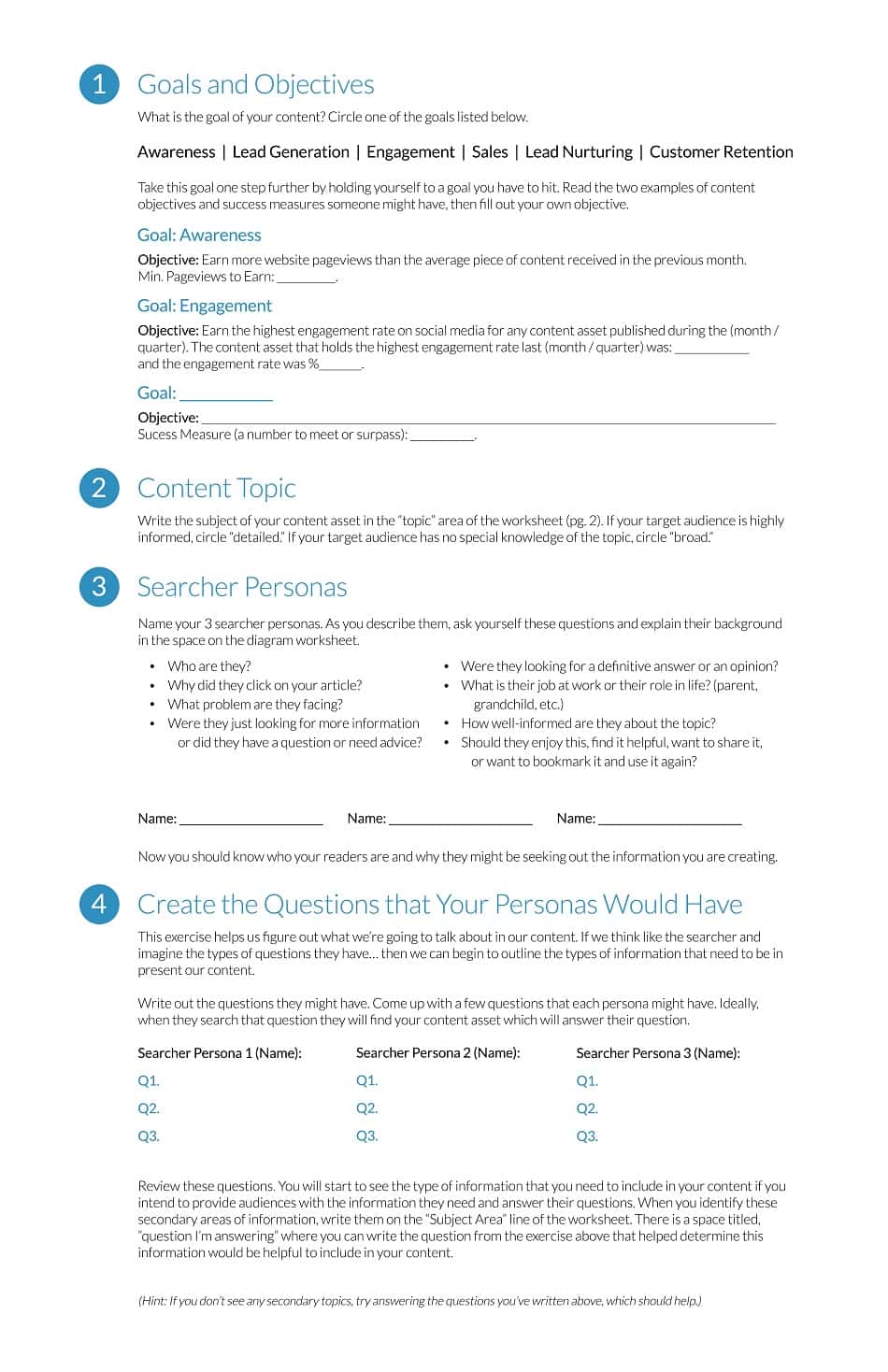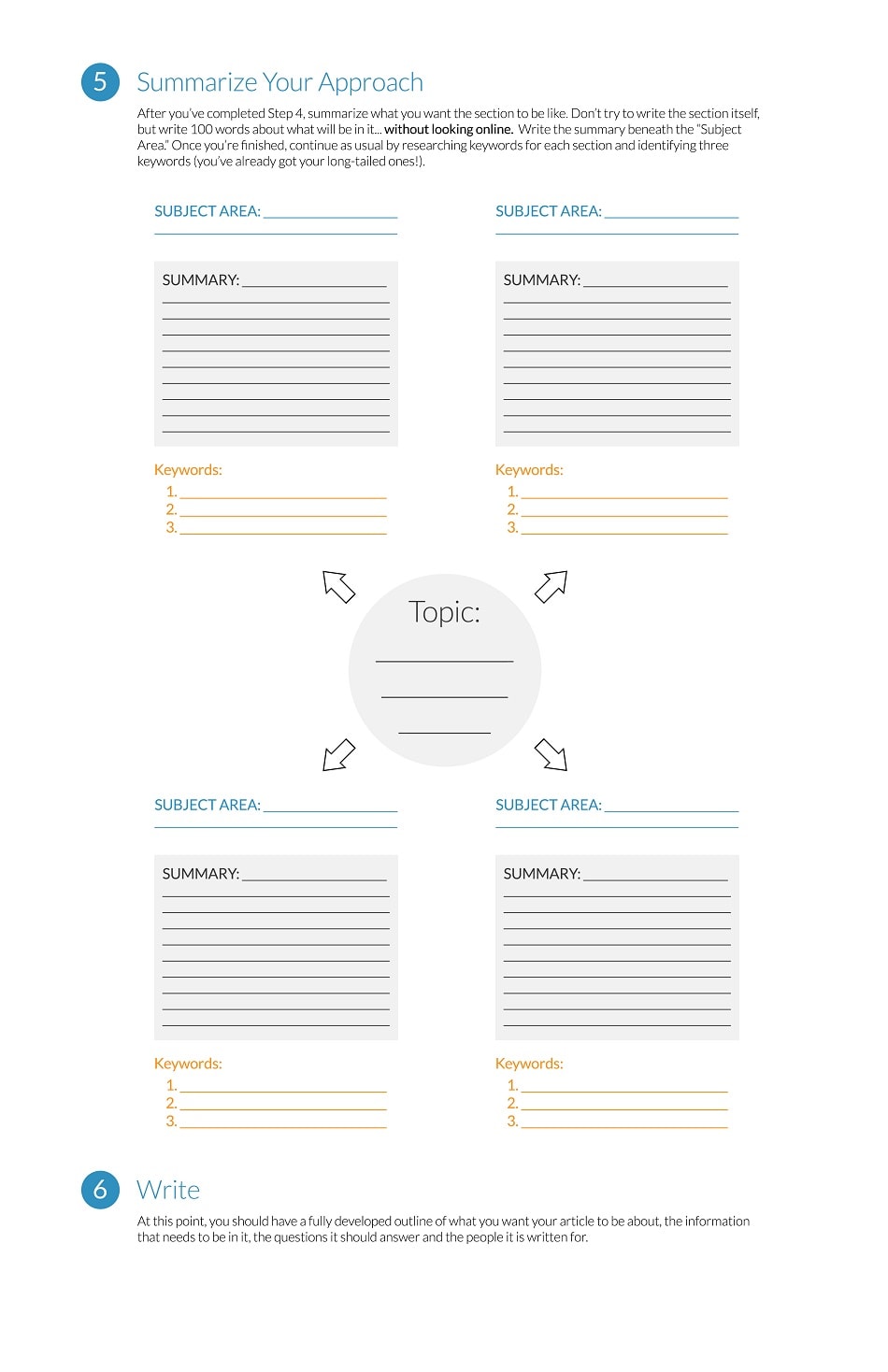Step-by-Step Guide on How to Easily Write Original Content
How to Practice Writing Original Content for Your Website
What if you don’t have the time to sleep on an idea and let it grow? With tight deadlines, sometimes you need a way to force yourself to work through an “original” idea. The worksheet below will help you get closer to original content, and includes elements that help with other important digital marketing aspects like searcher intent and long-tailed keywords. You should be able to complete these exercises without the aid of any online search tools. While it won’t guarantee an original idea, your article is much more likely to have a twist that others don’t or a new perspective that hasn’t been discussed to death. Forcing yourself to work this exercise will open your mind to new ways to write and help broaden the topics you touch on within your content piece.
Step 1: What is the Goal and Objective of Your Content Asset?
The examples below are how we define goals and objectives and don’t necessarily have to reflect your methods. However, it is important to establish how the success of your content piece will be measured before you begin writing or thinking of content ideas. Writing for a viral Facebook objective is considerably different than writing for e-newsletter sign-ups. If you’ve never established an objective before, you have to start somewhere so pick something below and start working toward it. Ultimately, you’ll begin to learn what types of articles, posts, infographics, videos, and more work best to accomplish your objectives.
Goal: Engagement
Objective: Increase website traffic in general. You might be able to stray slightly from the product- or service-focused content and work more toward a viral content piece. Measure success by comparing the pageviews for your piece to the average number of monthly pageviews for other content pieces.
Objective: Earn more social followers. Often, personal or community-based content that can live on Facebook does very well with increasing social likes and followers. Measure success by comparing the engagement rate of your content asset to the previous month or year average engagement rate.
Objective: Convert more social followers into website visitors. Measure success by finding out your average click-through-rate (CTR) from social shares to your website. Aim for above average CTR.
Goal: Awareness
Objective: Improve keyword rank. Make sure you pick keywords appropriately and pay extra attention to the searcher persona section of the article below. Measure success by monitoring traffic coming from this keyword over the next six months.
Objective: Educate readers about the company or a particular product or service. Measure success by aiming for an above average time on page for the content asset.
Goal: Website Conversions
Objective: Get a website conversion, i.e. increase newsletter sign-ups. Measure this by finding out the conversion rate (in Google Analytics) for the newsletter goal from the same source you’re promoting your content with and then aim for a higher conversion rate.
Step 2: Decide the Main Subject of Your Content
Write down the subject of your website content piece. If it’s not finalized yet, then write down a few of your original ideas and let the rest of the brainstorm exercises help you determine which will be your best final product. If you don’t have a lot of detail about your content topic, then keep it broad. If you’re well-versed in the industry, and your audience is too, then make it as specific as you can.
For the purpose of this exercise, let’s walk through the brainstorming process for an upcoming blog about click-through-rates (CTR).
Example Topic: Why you’re selling yourself short by only using CTR
Step 3: Create at Least 3 Searcher Personas
Assuming these are still within your target audience, start to describe the types of people who would like your article. You can make these individuals up. No one else is going to read this, but it will help you branch out and include more topics in your writing to make sure your personas can find what they want. Give them a name.
Ask These Questions as You Form Your Personas
- Who are they?
- Why did they click on your article?
- What problem are they facing?
- Were they just looking for more information or did they have a question or need advice?
- Were they looking for a definitive answer or an opinion?
- What is their job at work or their role in life? (parent, grandchild, etc.)
- How well-informed are they about the topic?
- Should they enjoy this, find it helpful, want to share it, or want to bookmark it and use it again?
If you haven’t decided on a topic yet, just see which of the answers comes more easily and start developing the personas. More than likely, you’ll settle on a subject for your content, or you’ll end up with a combination of them which is fine as well.
Example Personas
Deb: Deb is a senior digital marketing manager who has worked in her position for five plus years. She started as the manager of the IT team around 15 years ago, but her role has since expanded to include the new digital marketing the company is doing. Her digital marketing agency only reports CTRs to her, and Deb is beginning to wonder what it really means. Is there something else she should see or ask for? She is relatively green when it comes to the digital marketing side of things. As a result, she wants to do some digging before coming out and asking her digital agency why CTR is so important.
Dave: Dave works at a corporation and has been in marketing since he graduated college five years ago. He is transitioning into digital and has to put together a report for senior management. Off the top of his head, all Dave knows about is CTR, but he wants to impress management and include other metrics. He isn’t sure what to include, if he should include them or which ones are the most important.
Jeremy: Jeremy is senior management at a large business and manages all the divisions of the marketing teams. He has only ever seen top level CTR metrics for the digital campaigns, but the internal team is pressuring him to allow them to work on a more robust report. He wants to check if this is necessary and maybe find what other people are doing.
These are completely made up, but all feasible people. I want them to find my article and can assume some general situations they may be in. Now, I have an entire set of new sub-topics to write about.
Step 4: Identify What Your Searchers Need an Answer to
After you finish writing the personas, think about the questions they might have that would lead them to a search engine to look for an answer. Write these out and pull three to five of the best questions that your searchers have. If you have a longer word count to hit, pull five to seven major questions that you can focus a section of your content around. By isolating their questions, you able to directly answer them and use long-tailed keywords. At the very most, keep the questions you’re answering to seven or less. Including too many topics could confuse and lose the reader.
Example Questions for the Content to Answer
Who is looking at more than CTR?
- When do I need to start looking at more than CTR?
- What is the value of CTR?Are there more valuable metrics than CTR?
- Which metrics should I include when I report on digital?
- How do I combine more metrics into my report?
- How do I talk about them?
Place each question at the top of a list and then answer them in two or three different ways. At this point, you should start to see the sections of your article developing (and without any help from Google!).
Who is Looking at More than CTR?
- Digital media buyers (viewability, percent served)
- Social media implementers (engagement rate, relevancy score, page likes)
- Google analytics team members (time on page, bounce rate, pages viewed)
Step 5: Summarize Your Approach
After you’ve completed Step 4, summarize what you want the section to be like. Don’t try to write the section itself, but write 100 words about what will be in it... without looking online.
Example summary of the section, “Who uses more than CTR?”: Explain why these people have to look at more than CTR to do their jobs effectively. Mention some of the metrics that are probably most important to their roles and what a company could be missing if these team members aren’t being encouraged to spend time evaluating other metrics.
I could have talked about categories of companies like data-driven businesses, digital agencies and social media companies. Or I could have been more specific and drilled into one of those categories and talked about Droga5 or Huge. Instead, I chose to focus on people with specific job titles because of my searcher personas. There is no specific way to fill in the summary, but just start to answer your big questions and see where it takes you.
Once you are confident in the direction of the different sections and the article as a whole, feel free to lookup other resources and find facts to integrate into your content piece.
Follow along with the images below or download the PDF.
Download Guide


Stephanie Wubben
Stephanie is a strategic thinker. Challenging projects and situations drive her ambition to create thoughtful solutions for clients. With a background in market research, her love for measuring success and performance quickly led her into digital marketing where she endlessly tweaks and optimizes clients' campaigns until they're operating at peak performance.